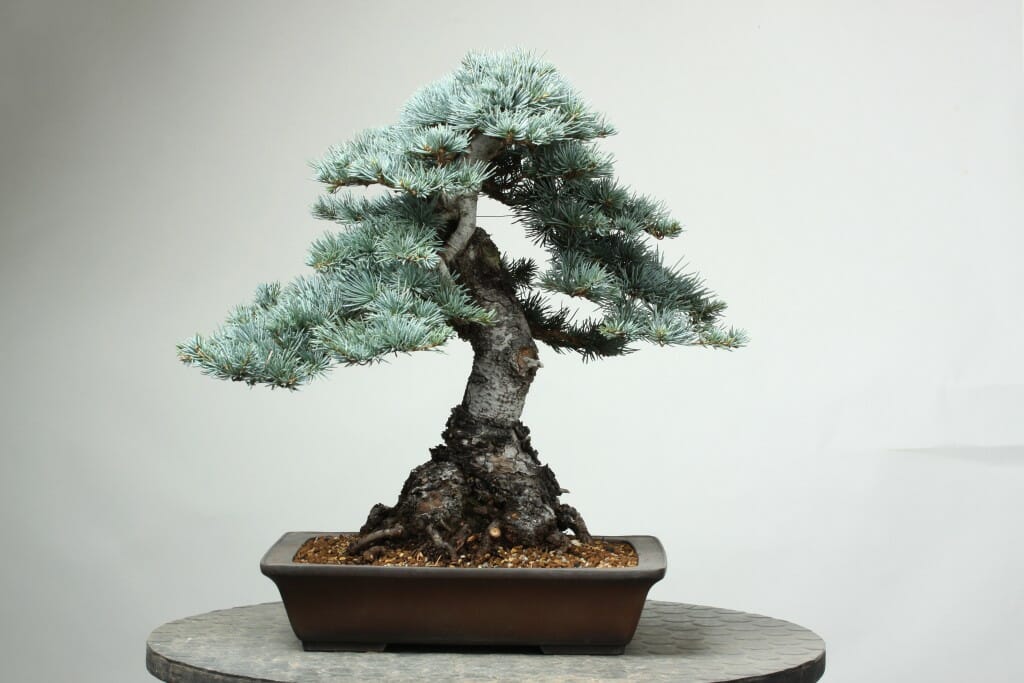Blue Atlas Cedar Bonsai trees need well-draining soil and regular watering. Prune them carefully to maintain their shape.
Blue Atlas Cedar Bonsai trees are captivating and resilient, making them a favorite among bonsai enthusiasts. These trees thrive in well-draining soil and require regular watering to maintain their health. Pruning is essential to shape the tree and promote growth.
Place them in a location with full sunlight to ensure they grow strong and vibrant. Fertilize during the growing season to provide necessary nutrients. Protect them from extreme temperatures, especially during winter. Regularly check for pests and diseases to keep them healthy. Blue Atlas Cedar Bonsai trees offer a rewarding experience for those dedicated to their care.

Credit: www.bonsaify.com
Introduction To Blue Atlas Cedar Bonsai
Blue Atlas Cedar bonsai trees require specific care to thrive. Ensure proper sunlight, regular watering, and well-draining soil. Pruning maintains their elegant shape.
Origin And History
The Blue Atlas Cedar is from the Atlas Mountains in Morocco. People have loved this tree for many years. It became popular in Europe in the 19th century. Today, many people grow it as a bonsai. This tree is known for its blue-green needles. The bark is rough and adds character to the bonsai.
Unique Characteristics
The Blue Atlas Cedar has a unique blue color. Its needles are short and dense. The tree grows in a pyramid shape. It can handle both hot and cold weather. This makes it a good choice for bonsai lovers. The tree’s bark is thick and brown. The branches spread out and create a nice shape. This tree can live for many years if cared for well.

Credit: m.youtube.com
Choosing The Right Tree
Selecting the Blue Atlas Cedar Bonsai requires understanding its specific care needs. Regular pruning, proper watering, and sufficient sunlight are essential for healthy growth.
Selecting A Healthy Specimen
Pick a tree with vibrant green needles. Avoid trees with yellow or brown needles. Check the roots. They should be firm and white. Avoid trees with mushy or dark roots. Look for a strong trunk. The trunk should not have any cracks or cuts. Inspect for pests. There should be no bugs or webs on the tree.
Ideal Size And Age
Choose a tree that is 5-7 years old. Younger trees are harder to shape. An older tree is easier to train. Select a tree that is 1-2 feet tall. This size is easier to manage. Avoid very large or very small trees. They can be harder to care for.
Planting And Positioning
The best soil mix for Blue Atlas Cedar Bonsai should be well-draining. A mix of akadama, pumice, and lava rock works best. This mix ensures that roots do not get waterlogged. Good drainage is key for healthy roots. Avoid using heavy, clay-rich soils. Such soils can retain too much water. This can lead to root rot.
Place the bonsai where it can get full sun. Six hours of sunlight each day is ideal. This helps the tree to grow strong and healthy. During winter, protect the bonsai from frost. A greenhouse or cold frame can be useful. Avoid placing the bonsai near heaters or vents. These can dry out the tree. A humid environment is also beneficial.
Watering Guidelines
Proper watering is essential for Blue Atlas Cedar Bonsai Tree care. Ensure the soil remains moist but not waterlogged. Adjust watering frequency based on climate and season.
Frequency And Amount
Water your Blue Atlas Cedar Bonsai tree regularly. Check the soil daily to avoid dryness. The soil should be moist but not soggy. Use a watering can for even distribution. Water deeply to reach the roots. Let the excess water drain out completely.
Signs Of Overwatering
Yellow leaves are a sign of overwatering. The soil may also smell bad. Check for mold on the soil surface. Soft or mushy roots indicate too much water. Adjust the watering schedule immediately.
Fertilizing Tips
Organic fertilizers are great for Blue Atlas Cedar Bonsai. These include fish emulsion, bone meal, and compost. They provide slow-release nutrients. Inorganic fertilizers are also useful. They come in liquid or granular forms. Choose a balanced mix like 10-10-10. This means equal parts nitrogen, phosphorus, and potassium.
Feed your Blue Atlas Cedar Bonsai every two weeks during the growing season. This is typically from spring to late summer. Reduce feeding to once a month in the fall. Stop fertilizing altogether in winter. Always water the tree well before applying fertilizer. This helps prevent root burn.
Pruning And Shaping
Pruning keeps the Blue Atlas Cedar Bonsai small and tidy. Use sharp, clean scissors for pruning. Remove dead or damaged branches first. Cut back new growth to control shape. Always make clean cuts to avoid damage. Do not prune more than one-third of the tree at a time. This helps the tree stay healthy.
Advanced styling requires more skill and patience. Use wiring techniques to shape branches. Wrap wire around branches to bend them gently. Check the wires regularly to avoid cutting into the bark. Remove wires when branches hold their shape. Create a balanced look by shaping all sides evenly. Take time to study the tree’s natural form. This helps achieve a beautiful design.
Pest And Disease Management
Blue Atlas Cedar Bonsai can face aphids and spider mites. Fungal infections also occur. Brown needles indicate root rot. Yellow leaves mean poor soil drainage.
Ensure the bonsai gets proper sunlight. Use well-draining soil. Inspect leaves for pests regularly. Neem oil helps deter insects. Prune dead branches to avoid disease. Water the tree sparingly to prevent root rot.
Seasonal Care
Blue Atlas Cedar Bonsai needs proper protection during winter. Keep the tree in a cool place to avoid freezing. Use a cold frame or an unheated garage for this. Make sure the tree receives indirect sunlight. Water the tree sparingly in winter. Too much water can cause root rot. Monitor the soil moisture regularly. Protect the tree from harsh winds and heavy snow. Mulching can help insulate the roots.
During summer, the Blue Atlas Cedar Bonsai needs extra attention. Ensure the tree gets plenty of sunlight. Water the tree daily in hot weather. Avoid overwatering to prevent root rot. Fertilize the tree once a month with a balanced fertilizer. Prune the branches to maintain the shape. Watch for pests and treat them promptly. Mist the foliage to keep it hydrated. Shade the tree during extreme heat. Regular maintenance keeps the tree healthy and thriving.
Repotting Procedures
Repot the Blue Atlas Cedar Bonsai every two to three years. Early spring is the best time for this task. Look at the roots to decide if repotting is needed. If roots are circling the pot, it is time to repot.
- Remove the tree from its pot gently.
- Trim one-third of the roots using sharp scissors.
- Prepare a new pot with fresh soil.
- Place the tree in the center of the new pot.
- Fill the pot with soil, covering the roots completely.
- Water the tree thoroughly to settle the soil.
- Place the bonsai in a shaded area for a week.
- Return to its usual spot after recovery.

Credit: www.bonsaify.com
Conclusion
Caring for a Blue Atlas Cedar bonsai can be rewarding. Consistent watering, proper pruning, and suitable sunlight are key. Remember to protect it from extreme weather conditions. With dedication and attention, your bonsai will thrive. Enjoy the beauty and tranquility it brings to your space.
Happy bonsai gardening!

